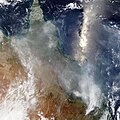 Artistic rendering of the Terra satellite | |
| Names | EOS AM-1 |
|---|---|
| Mission type | Climate research |
| Operator | NASA |
| COSPAR ID | 1999-068A |
| SATCAT no. | 25994 |
| Website | terra |
| Mission duration | Elapsed: 25 years, 9 months and 22 days |
| Spacecraft properties | |
| Manufacturer | NASA |
| Launch mass | 4,864 kilograms (10,723 lb) |
| Start of mission | |
| Launch date | December 18, 1999, 18:57:39 UTC |
| Rocket | Atlas IIAS AC-141 |
| Launch site | Vandenberg SLC-3E |
| Contractor | ILS |
| End of mission | |
| Disposal | Deorbited |
| Last contact | 2025-2026 (planned) |
| Orbital parameters | |
| Reference system | Geocentric |
| Regime | Low Earth |
| Semi-major axis | 7,080.0 kilometers (4,399.3 mi) |
| Eccentricity | 0.0001392 |
| Perigee altitude | 708.7 kilometers (440.4 mi) |
| Apogee altitude | 710.6 kilometers (441.5 mi) |
| Inclination | 98.2098° |
| Period | 98.8 minutes |
| RAAN | 251.3130 degrees |
| Argument of perigee | 83.7699 degrees |
| Mean anomaly | 276.3654 degrees |
| Mean motion | 14.57110250 |
| Epoch | 25 June 2016, 02:58:27 UTC |
| Revolution no. | 87867 |
 Large Strategic Science Missions Earth Science Division | |
Terra (EOS AM-1) is a multi-national scientific research satellite operated by NASA in a Sun-synchronous orbit around the Earth. It takes simultaneous measurements of Earth's atmosphere, land, and water to understand how Earth is changing and to identify the consequences for life on Earth. [1] It is the flagship of the Earth Observing System (EOS) and the first satellite of the system which was followed by Aqua (launched in 2002) and Aura (launched in 2004). Terra was launched in 1999.
Contents
- Launch
- Instruments
- Operations
- Malicious cyber activities
- Gallery of images by Terra
- See also
- References
- External links
The name "Terra" comes from the Latin word for Earth. A naming contest was held by NASA among U.S. high school students. The winning essay was submitted by Sasha Jones of Brentwood, Missouri. The identifier "AM-1" refers to its orbit, passing over the equator in the morning.











